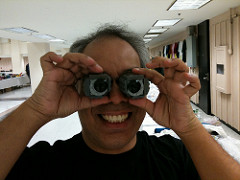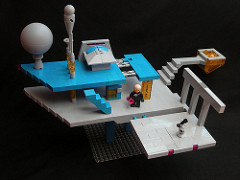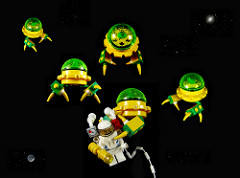For interview number 10, Keith Goldman chats with on one of our own. Take it away, Keith!
Although my next guest prefers to build in one genre, he is a bit of a Renaissance man in the hobby. Dan “Happy Weasel” Rubin has been an Ambassador, Administrator for CSF, convention coordinator, Brother Brick, active WamaLUG member, contest sponsor… And the list goes on. Dan and I have twice shared the low-budget convention experience, and the abject terror of a fellow AFOL emerging from the bathroom in a pair of too-tight red briefs… and nothing else. Dan is also a lawyer, but we won’t hold that against him for the purposes of this interview.
I sat down with Dan Rubin during my trial for manslaughter in the nation’s capital. During a recess for a witness to compose himself, we talked about art-school chicks, Gymkata vs Rexkwondo and the horrors of Kentucky. We also talked about LEGO.
The Build
 KG: How early in your build process do you decide the color scheme in a build? You’ve publicly declared a foot fetish and admitted that this MOC was based in color scheme, off of this sneaker, is there any other garment, item, or device you have taken inspiration for your palette?
KG: How early in your build process do you decide the color scheme in a build? You’ve publicly declared a foot fetish and admitted that this MOC was based in color scheme, off of this sneaker, is there any other garment, item, or device you have taken inspiration for your palette?
DR: The color scheme of a build is a very early choice for me. Usually, I’ll decide on a shape/style, and then the color scheme is the second choice, before I put two bricks together. That is, unless I want to try to create a shape that I’ve never attempted before, and I have to prototype it. Sometimes I’ll change the exact placement of stripes, and finer details of a color scheme as the build progresses, but the color combination, and general color blocking are early decisions.
As far as inspiration is concerned, I suppose that it can come from just about anywhere. The shoe-inspired ship is definitely the most explicit example of an inspiration for a color scheme among my builds, though. I built a police ship once that drew its color scheme from the ubiquitous “black and whites” of the LAPD, but since that was intended to be a lineal descendant of the inspiration, I’m not sure it’s what you’re looking for.
Right now, I’m working on something in dark blue and lime, which is a color scheme I cooked up playing around with the colors while sorting. As you may have noticed, I like contrast between the colors of my models. I’ll usually use one neutral color for greebles, and then two more colors that will set each other off, or possibly just one color that contrasts with the greeble color (dark bley is a lot less neutral than old light gray, for instance).
KG: Can you think of any attitude towards building that you used to adhere to that you no longer do?
DR: This is a tough question, it’s going to take some thought. Generally speaking, I’ve had to make LEGO building a far smaller part of my life lately, as real life issues have taken hold, but that’s not really an attitude towards building as much as it’s a forced change in priorities. Lately, I have been trying to embrace colors that I once disliked. I’ve tried to take on orange and red in particular, as well as lime, to which I used to be ambivalent.
When I first joined the AFOL community, all the spacers were building in themes, and I jumped on that bandwagon. Lately, I’ve been trying to cast my net wider, and embrace any idea that I find, rather than trying to force another creation on a theme that’s likely already stretched thin. That’s not to say that I don’t build things into a theme on occasion, but I am trying for more variety.

KG: Do you have a different approach for building models for a convention as opposed to a standard internet posting?
DR: Absolutely! There are a lot of considerations that arise when you’re building for a convention, rather than for posting on the internet. Stability is a pretty major difference, as you have to be prepared for tables to be jostled, or worse, your creation to be grabbed in a fragile spot. Viewing angles are also important. Building a diorama for internet posting, you can leave large spans of back-side completely un-treated. When you’re going to display a diorama at a convention, you have to consider where people will be able to view your creation from.
When Nick and I built the Faded Giant, we decided on a triangle shape, which would allow viewing from a much wider angle than a rectangle with three tall sides. It also allowed us to force our own background on more viewing angles, rather than leaving the chaos of the convention hall visible behind the display.
Transport is also a huge factor. When building something to post on the internet, it doesn’t have to be able to fit through the door of your legoratory, or into your car. I built the landscape and most of the vehicles for the Faded Giant display, and they all come apart to be transported. The entire landscape splits into a series of 48×48 baseplates, which all fit in a box about 16 inches tall. The details all got thrown on for the first time at the convention. Similarly, Nick built the building to split into more manageable sections for transportation. After all, nobody wants to carry something six or more feet long.
More of Keith’s interview with Dan after the jump: Continue reading →
The Brothers Brick is funded by our readers and the community. Articles may include affiliate links, and when you purchase products from those links, TBB may earn a commission that helps support the site.














 Though nearly all of us knew him only as
Though nearly all of us knew him only as 
